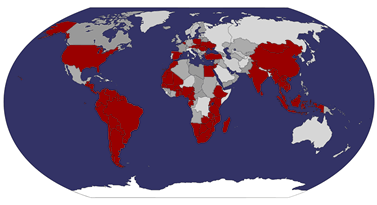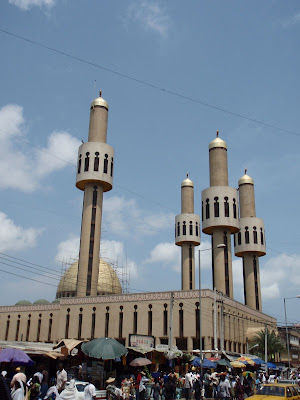If we had to choose one contribution of Nigeria to the global food scene, it would be suya. Suya is thinly sliced beef, marinated, grilled, and cut into small, bite-size pieces. Most often it is served with onion and toothpicks for eating. This picture is not great, but is typical suya. This one is from a fancy bar, but our favorite suya vendor was an old Muslim man cooking it over a fire made of two-by-fours from a scrap heap. His was excellent.
 Like most of the surrounding coutries, typical Nigerian food consists of a ball of starch and then a sauce. This one is called ebe, and we can't really tell you how it differs from most of the other similar things we have eaten. This sauce had some secret fish that they didn't tell us about, but was otherwise not bad.
Like most of the surrounding coutries, typical Nigerian food consists of a ball of starch and then a sauce. This one is called ebe, and we can't really tell you how it differs from most of the other similar things we have eaten. This sauce had some secret fish that they didn't tell us about, but was otherwise not bad. While staying with Ashraf in Lagos (who was awesome), we explored his neighborhood and discovered a guy selling food down the road to construction workers and guards in the posh neighborhood. He was very happy to have us and we liked the beans and rice so much that we came back later for more. Unfortunately, we think that it made us sick, as our digestive systems were unhappy for a couple of days.
While staying with Ashraf in Lagos (who was awesome), we explored his neighborhood and discovered a guy selling food down the road to construction workers and guards in the posh neighborhood. He was very happy to have us and we liked the beans and rice so much that we came back later for more. Unfortunately, we think that it made us sick, as our digestive systems were unhappy for a couple of days. A popular maker of dairy products in Nigeria is Dudu. The name alone amuses me, but they also make some crazy products. Here is an aloe milk that Tara had. Pretty good, but a bit weird.
A popular maker of dairy products in Nigeria is Dudu. The name alone amuses me, but they also make some crazy products. Here is an aloe milk that Tara had. Pretty good, but a bit weird. I also got a fruit cocktail milk, which was super sweet and, therefore, gets high marks from me. Tara made me hold her Hollandia blueberry yogurt, which I would never drink. She thought it was decent and it is shelf-stable, so no refridgeration needed.
I also got a fruit cocktail milk, which was super sweet and, therefore, gets high marks from me. Tara made me hold her Hollandia blueberry yogurt, which I would never drink. She thought it was decent and it is shelf-stable, so no refridgeration needed. Lagos had ice cream vendors on the street who make these tiny one-bite ice cream cones for about 7 cents. But the funny part is that the guy uses one of those tiny sample spoons to dip it out of a big box, so this cone is really like 50 scoops with his tiny spoon.
Lagos had ice cream vendors on the street who make these tiny one-bite ice cream cones for about 7 cents. But the funny part is that the guy uses one of those tiny sample spoons to dip it out of a big box, so this cone is really like 50 scoops with his tiny spoon. We have found some good meat pies in various former British places, but the "meat" pies of Nigeria did not stack up. The primary problem is that they never seemed to have meat. Sometimes flavored potatoes, sometimes macaroni (weird), but we must have bought five meat pies and not one had meat. I finally started asking people if their meat pies had meat, and most would just laugh.
We have found some good meat pies in various former British places, but the "meat" pies of Nigeria did not stack up. The primary problem is that they never seemed to have meat. Sometimes flavored potatoes, sometimes macaroni (weird), but we must have bought five meat pies and not one had meat. I finally started asking people if their meat pies had meat, and most would just laugh. While in Lagos, we went to a real, American-style barbecue complete with hamburgers, hotdogs, and chicken. Thanks to all of Ashraf's friends for making it a great experience! The hotdogs were especially good.
While in Lagos, we went to a real, American-style barbecue complete with hamburgers, hotdogs, and chicken. Thanks to all of Ashraf's friends for making it a great experience! The hotdogs were especially good. A pastor and his wife were very kind to us and shared a taxi. While waiting on a taxi, the woman bought these leaf steamed things and was kind enough to give us one. They are corn and taste like a decent corn mush.
A pastor and his wife were very kind to us and shared a taxi. While waiting on a taxi, the woman bought these leaf steamed things and was kind enough to give us one. They are corn and taste like a decent corn mush. Tara wasn't feeling great, so I bought her a Lucozade Boost, which I thought was like Gatorade, but is apparently more like Red Bull. It didn't help her.
Tara wasn't feeling great, so I bought her a Lucozade Boost, which I thought was like Gatorade, but is apparently more like Red Bull. It didn't help her. Tara had one taste of a malt beverage and decided that she liked it. In this picture, she has bought one of her own along with a donut. She realized about 30 seconds after this that malted beverages (which taste mostly of molasses) are gross. But donuts are still good.
Tara had one taste of a malt beverage and decided that she liked it. In this picture, she has bought one of her own along with a donut. She realized about 30 seconds after this that malted beverages (which taste mostly of molasses) are gross. But donuts are still good. In Nigeria, FanIce is expensive and harder to find, but we found this knock-off ice cream for less. It probably didn't actually have any dairy in it, but it was not the worst frozen liquid that I have ever tasted.
In Nigeria, FanIce is expensive and harder to find, but we found this knock-off ice cream for less. It probably didn't actually have any dairy in it, but it was not the worst frozen liquid that I have ever tasted. Sometimes while in a taxi or bus, the taxi/bus slows down at a police roadblock, and you reach out the window and buy something that you don't know what it is from a woman who throws it at you while you throw money back at her. These turned out to be bean beignets with a slice of hot pepper on top. Not bad.
Sometimes while in a taxi or bus, the taxi/bus slows down at a police roadblock, and you reach out the window and buy something that you don't know what it is from a woman who throws it at you while you throw money back at her. These turned out to be bean beignets with a slice of hot pepper on top. Not bad. I was happy to find a liter of FanIce in the fancy supermarket when I was hungry one night. Unfortunately, it had separated and refrozen, which meant a crazy unsweetened Coolwhip-like stuff on the top layer and a sweet, icy layer on bottom. The last time that we buy a big thing of FanIce.
I was happy to find a liter of FanIce in the fancy supermarket when I was hungry one night. Unfortunately, it had separated and refrozen, which meant a crazy unsweetened Coolwhip-like stuff on the top layer and a sweet, icy layer on bottom. The last time that we buy a big thing of FanIce. We then found a good softserve place in Calabar. The ice cream you see, it was about $1.50, which is expensive, but it was good. The funny thing is that we came back the next day and they guy said the price was now $2. We questioned it and he said that his boss decided that too many people were getting that size, so he raised the price. We then left without our day's ice cream.
We then found a good softserve place in Calabar. The ice cream you see, it was about $1.50, which is expensive, but it was good. The funny thing is that we came back the next day and they guy said the price was now $2. We questioned it and he said that his boss decided that too many people were getting that size, so he raised the price. We then left without our day's ice cream. While at Afi Mountain, we cooked for the first (and second) times in all of Africa. Not very exciting--pasta with chickpeas and onions--but we ate a pound of pasta between the two of us, so at least we had a lot of it.
While at Afi Mountain, we cooked for the first (and second) times in all of Africa. Not very exciting--pasta with chickpeas and onions--but we ate a pound of pasta between the two of us, so at least we had a lot of it. Foods of Nigeria are now complete. We did not bring you any pictures from expensive restaurants because we did not eat in any expensive restaurants. Most food in Nigerian restaurants costs about the same as American restaurants for those who are curious. That was too much for our wallets.
Foods of Nigeria are now complete. We did not bring you any pictures from expensive restaurants because we did not eat in any expensive restaurants. Most food in Nigerian restaurants costs about the same as American restaurants for those who are curious. That was too much for our wallets.Nigerian food definitely continues on the West African continuum, but by the time we got to southern Nigeria, there was starting to be less manioc/yam. That carries on through Cameroon. The meat on a stick changes a bit, but the grilled meat also starts becoming more popular.
























































